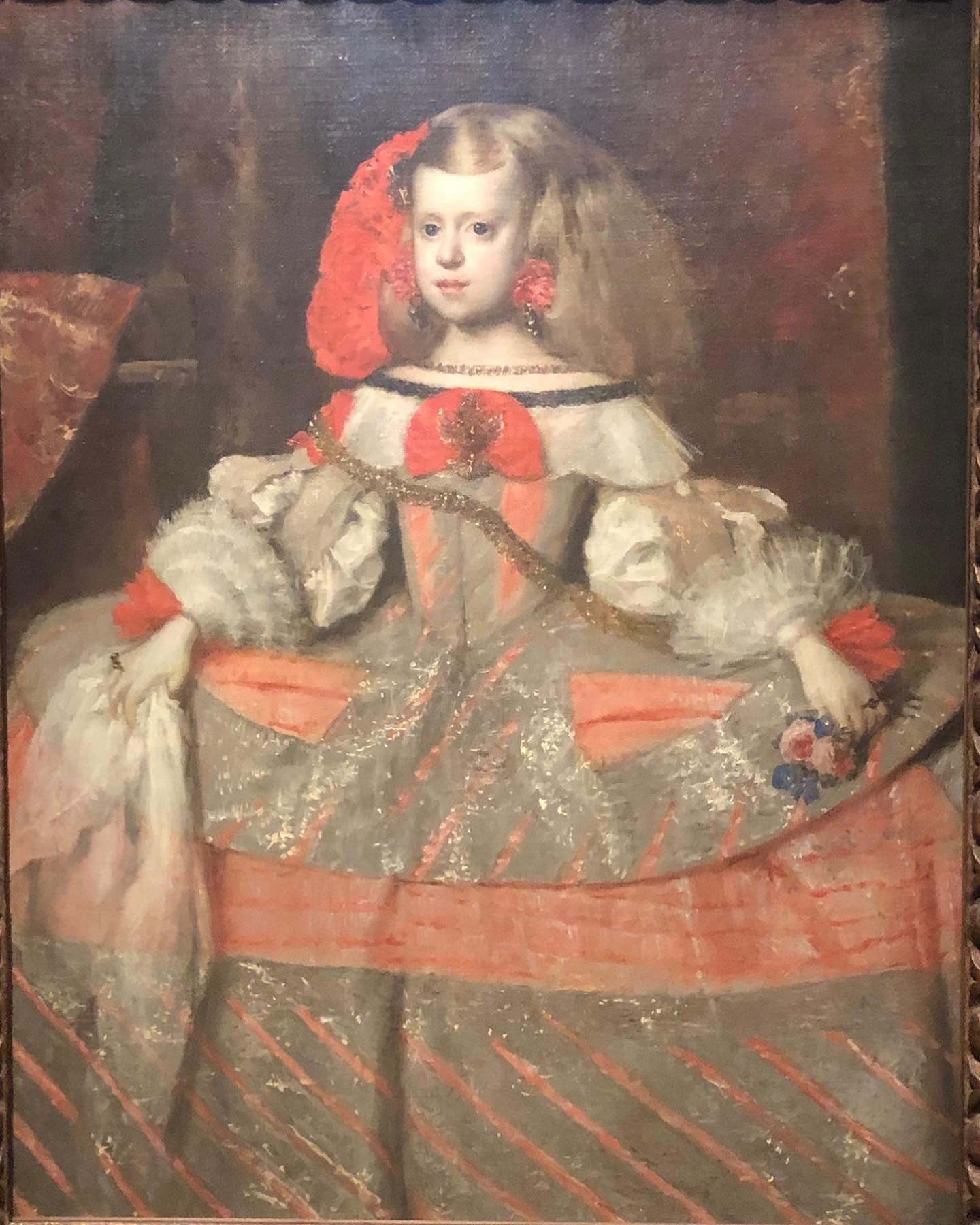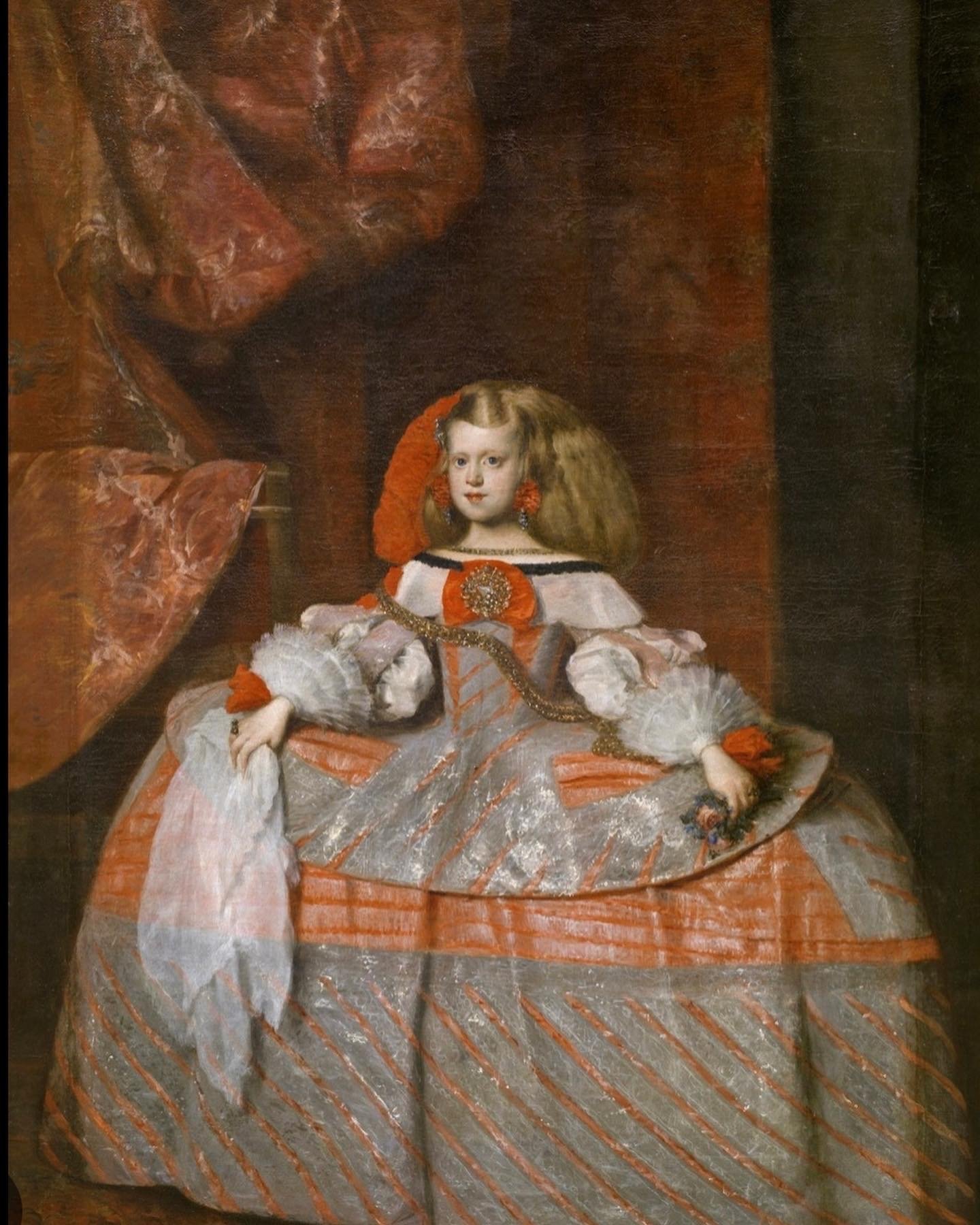The portrait of the Spanish Infanta and the Covent Garden Rose Adagio
How does a famous portrait of a Spanish infanta (later empress of Austria) connect to the ballet of “The Sleeping Beauty”?
The first painting (1) is in the Kunsthistorisches Museum, Vienna, where I saw it on October 10. It depicts Margarita Teresa (1651 -1673), daughter of king Philip IV of Spain (1605 - 1665), at age eight or nine She was already engaged to the future Leopold I of Austria, who, thanks to the Habsburg fatal addiction to incestuous in-breeding between uncles and nieces, was both her maternal uncle and paternal cousin (to name only their two closest family relationships), which is why she here wears a double headed eagle as brooch, the Austrian insignia. (Margarita Teresa’s mother, Maria Anna of Austria, and her husband Philip IV were uncle and niece.) Unlike her brother Philip, Margarita Teresa had none of the disabilities that often attended in -breeding; she was lively, and considered “a little angel”.
The painter of this portrait was Juan Bautista Martínez de Mazo (c.1612 -1667), son-in-law to the great Diego Velásquez (1599-1660), to whom a very similar portrait of the same Habsburg infanta (2) is attributed. Certainly Velásquez painted Margarita on several occasions, and at least once in this pink dress.
The ballerina Pamela May, the second to dance Aurora in the Sadler’s Wells Ballet production at Covent Garden in 1946 -1948, told her former student Gail Monahan (to whom I owe this information) that Oliver Messel, the production’s designer, took his inspiration from one of these Velásquez/de Mazo portraits of Margarita when he designed the tutu for Princess Aurora’s first-act birthday appearance. Hence Aurora’s long and billowing sleeves, which took some viewers aback in 1946 but which became classic. Actually the Messel costumes evolved over the more than twenty years of this production: the Covent Garden archives displayed c.2005 a Fonteyn -Messel Aurora tutu significantly different in detail - especially the layering and rose ornments of the skirt - from the ones seen in 3, 4, 5, and 6 here. Even so, we can see how Aurora’s tutu, even as seen in Peter Farmer’s post-Messel 2005 production still performed at Covent Garden today, derived from the pink dress worn by Margarita Teresa in these c.1660 portraits.
Margarita Teresa not only married Leopold I, whom she accurately called “Onkel” (“Uncle”), but had four children by him before she herself died at age twenty -one. She remained Spanish in her tastes and language - and in her fondness for having ballets staged at court. Unfortunately, three of her children died; and more appallingly she is said to have made her husband expel the Jews from Vienna, blaming them somehow for her children’s deaths. Her surviving daughter, María Antonia (1669 -1692), became princess of Bavaria by marriage; when Maria Antonia’s son Joseph Ferdinand of Bavaria (1692-1699) died in boyhood, it triggered a crisis for the Habsburg succession to the Spanish monarchy that in turn caused the great international power conflict of the 1701-1714 war of the Spanish Succession, famous for the battles of Blenheim, Ramillies, Oudenarde, and Malplaquet, in which John Churchill, first Duke of Marlborough, became known as the master military strategist of Europe. Who knew such things were in store when this portrait was painted?
Monday 10 October 2022
@Alastair Macaulay 2022
1. The Spanish infant Margarita, daughter of Philip IV of Spain and future empress of Austria, as portrayed by Juan Martínez de Mazo. Vienna, Kunsthistorisches Museum
.
2.The same infanta Margarita Teresa, in a portrait widely attributed (if not by all) to Diego Velásquez. Prado Museum, Madrid.
3. A costume sketch by Oliver Messel for Princess Aurora in “The Sleeping Beauty”.Messel’s designs were used at Covent Garden between 1946 and 1968, with various revisions.
4. An online Victoria and Albert Museum photograph of a tutu designed by Oliver Messel and worn by Margot Fonteyn as Princess Aurora in Act One. This differs considerably in detail (especially in the skirt) from a Messel-Fonteyn Aurora Act One tutu displayed at Covent Garden c.2005, but both employ the long translucent sleeves apparently inspired by the portrait of the infanta.
5. A photograph (surely posed) of Margot Fonteyn in the Act One Rose Adagio of “The Sleeping Beauty”.
6. A studio portrait photograph of Margot Fonteyn as Princess Aurora in Act One of “The Sleeping Beauty”. She wears a Messel-designed tutu, though this differs in some respects from one in the Covent Garden archive.
7. The infanta Margarita Teresa painted by Velásquez in another pink dress (1653)
8.The infanta Margarita Teresa in a blue dress, again painted by Velásquez (1659).
9.Velásquez made the infanta Margarita the centrepiece of his “Las Meninas”, often considered the greatest and most ambiguous painting ever painted.








